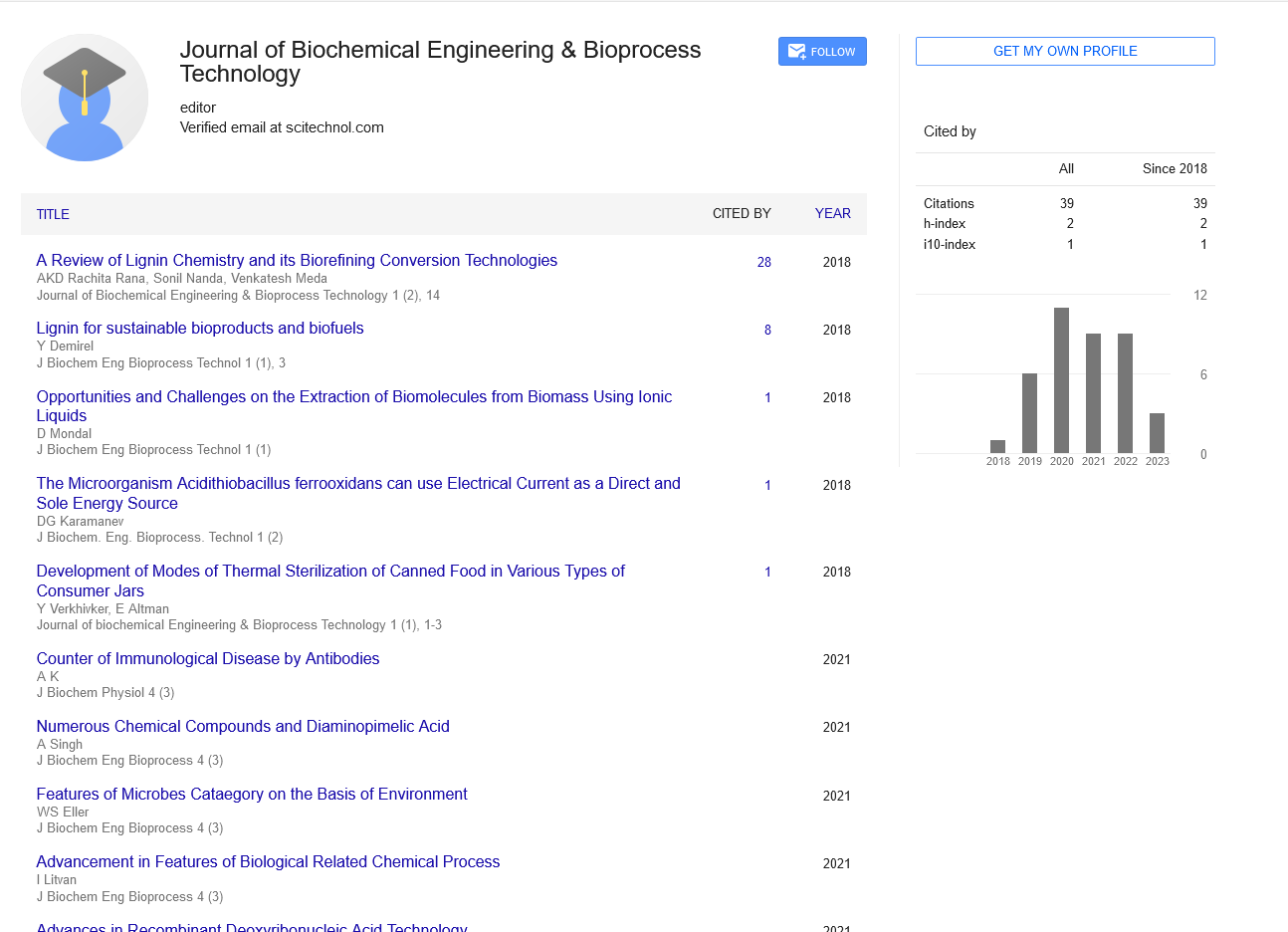Commentary, J Biochem Eng Bioprocess Vol: 4 Issue: 5
Specialized Field of Utilizing Magnifying Lens to See Items and Spaces of Articles
Joseph Philips*
Department of Biotechnology, California Institute of Technology, USA
*Corresponding author: Philips J
California Institute of Technology, USA
E-mail: josephilips@gmail.com
Received date: September 1, 2021; Accepted date: September 16, 2021; Published date: September 22, 2021
Abstract
Microscopy is the specialized field of utilizing magnifying lens to see items and spaces of articles that can't be seen with the unaided eye (protests that are not inside the goal scope of the typical eye). There are three notable parts of microscopy: optical, electron, and examining test microscopy, alongside the arising field of X-beam microscopy. Optical microscopy and electron microscopy include the diffraction, reflection, or refraction of electromagnetic radiation/electron radiates cooperating with the example, and the assortment of the dissipated radiation or one more sign to make a picture.
Keywords: Microscopy
Introduction
Microscopy is the specialized field of utilizing magnifying lens to see items and spaces of articles that can't be seen with the unaided eye (protests that are not inside the goal scope of the typical eye). There are three notable parts of microscopy: optical, electron, and examining test microscopy, alongside the arising field of X-beam microscopy. Optical microscopy and electron microscopy include the diffraction, reflection, or refraction of electromagnetic radiation/electron radiates cooperating with the example, and the assortment of the dissipated radiation or one more sign to make a picture. This cycle might be completed by wide-field illumination of the example (for instance standard light microscopy and transmission electron microscopy) or by checking a fine bar over the example (for instance confocal laser examining microscopy and filtering electron microscopy). Filtering test microscopy includes the collaboration of a checking test with the outer layer of the object of interest. The advancement of microscopy changed science, brought about the area of histology thus stays a fundamental method in the life and actual sciences. X-beam microscopy is three-dimensional and non-damaging, taking into account continued imaging of a similar example for in situ or 4D investigations, and giving the capacity to "see inside" the example being concentrated prior to forfeiting it to higher goal strategies. A 3D X-beam magnifying lens utilizes the strategy of registered tomography (micro CT), turning the example 360 degrees and remaking the pictures. CT is regularly done with a level board show. A 3D X-beam magnifying lens utilizes a scope of targets, e.g., from 4X to 40X, and can likewise incorporate a level board. The field of microscopy (optical microscopy) traces all the way back to basically the seventeenth century. Prior magnifying instruments, single focal point amplifying glasses with restricted amplification, date basically as far back as the wide spread utilization of focal points in eyeglasses in the thirteenth century[3] however further developed compound magnifying lens initially showed up in Europe around 1620 The soonest specialists of microscopy incorporate Galileo Galilei, who found in 1610 that he could close concentrate his telescope to see little items close up and Cornelis Drebbel, who might have designed the compound magnifying lens around 1620 Antonie van Leeuwenhoek fostered an extremely high amplification straightforward magnifying instrument during the 1670s and is regularly viewed as the principal recognized microscopist and microbiologist. Optical or light microscopy includes passing apparent light sent through or reflected from the example through a solitary focal point or various focal points to permit an amplified perspective on the example. The subsequent picture can be recognized straight by the eye, imaged on a visual plate, or caught carefully. The single focal point with its connections, or the arrangement of focal points and imaging gear, alongside the suitable lighting hardware, test stage, and backing, makes up the essential light magnifying lens. The latest advancement is the computerized magnifying lens, which utilizes a CCD camera to zero in on the display of interest. The picture is displayed on a PC screen, so eyepieces are pointless.
Live cells specifically by and large need adequate differentiation to be concentrated effectively, since the inner designs of the phone are dull and straightforward. The most widely recognized approach to expand contrast is to stain the various constructions with particular colors, however this regularly includes killing and fixing the example. Smudging may likewise present relics, which are obvious underlying subtleties that are brought about by the handling of the example and are in this way not genuine elements of the example. By and large, these methods utilize contrasts in the refractive list of cell structures. Brilliant field microscopy is similar to glancing through a glass window: one sees not the glass but rather only the soil on the glass. There is a distinction, as glass is a denser material, and this makes a distinction in period of the light going through. The natural eye isn't delicate to this distinction in stage, however shrewd optical arrangements have been formulated to change this distinction in stage into a distinction in adequacy.
 Spanish
Spanish  Chinese
Chinese  Russian
Russian  German
German  French
French  Japanese
Japanese  Portuguese
Portuguese  Hindi
Hindi 